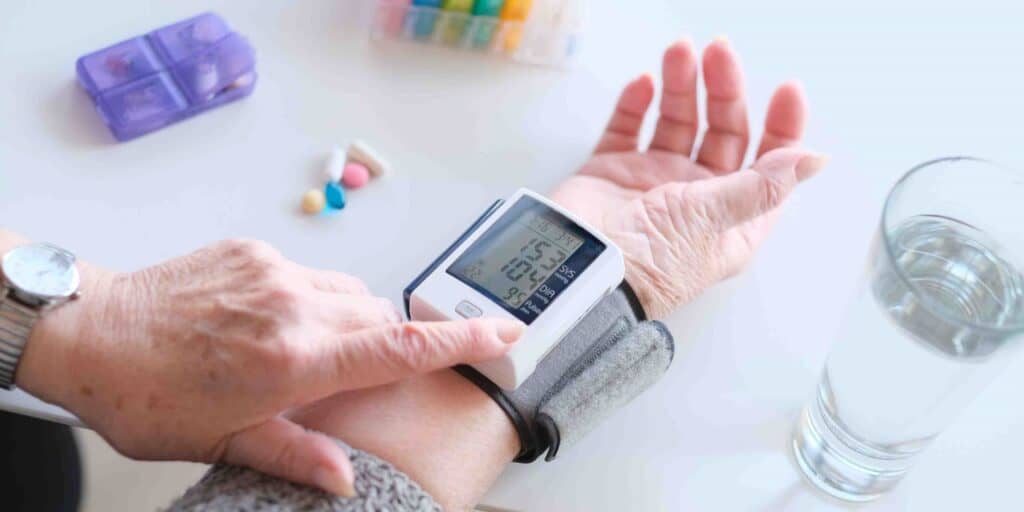Are you or a loved one dealing with an abdominal aortic aneurysm (AAA)? Living with or having surgery for an AAA can be a frightening experience, and it’s important to understand the diagnosis and treatment options available in Singapore. In this blog post, we will discuss what an AAA is, causes and risk factors, how it’s diagnosed, existing treatments, post-treatment care, self-monitoring tools, lifestyle changes, emergency care, clinical trials, payment options, and more.
Introduction to Abdominal Aortic Aneurysm (AAA)
An abdominal aortic aneurysm (AAA) is a bulge in the wall of the aorta — the body’s main artery — that forms in the abdomen. The aorta is a strong artery that carries oxygen-rich blood away from the heart to other parts of the body but an AAA occurs when there is a weak spot on the wall of the artery that expands and bulges outwardly. An AAA can be dangerous if it enlarges too much or ruptures. If an AAA ruptures, it can cause severe internal bleeding and even death.
Causes and Risk Factors of AAA

The exact cause of AAA is not known but certain factors can increase your risk of developing an AAA. These risk factors include age (50+ significantly increases your risk), male gender, smoking/chewing tobacco, obesity, hypertension (high blood pressure), high cholesterol, family history, chronic obstructive pulmonary disease (COPD), and atherosclerosis (hardening of the arteries).
Symptoms of AAA

In many cases, an AAA does not cause any symptoms until it has grown to a large size or has ruptured. In some cases, people with an AAA may experience pain in the abdomen, lower back or groin area. Other symptoms to look out for include a feeling of fullness or pressure in the abdomen, back pain that may extend to the buttocks, nausea or vomiting.
Diagnosis of AAA
Your doctor may use several tests to diagnose an AAA. These tests include ultrasound, CT (computed tomography) scan and MRI (magnetic resonance imaging). Your doctor may also order blood tests to check for signs of internal bleeding.
Treatment Options for AAA
If you are diagnosed with an AAA, your doctor will discuss available treatment options with you. The treatment options for AAA depend on several factors such as size and location of your aneurysm, your age and overall health condition. Treatment options for AAA includes surgery, endovascular repair or open repair.
Surgery for AAA in Singapore
Surgery is the most common form of treatment for AAA in Singapore. Surgery is typically recommended for people with large aneurysms that have reached 5 cm or larger in size. There are two types of surgery for AAA: open repair and endovascular repair.
Endovascular Repair of AAA in Singapore
Endovascular repair is a minimally invasive technique used to repair an AAA without making any incisions on the abdomen. It involves placing a catheter through an artery in the groin area up to the aorta and inserting a stent-graft (a tube-shaped device) inside the artery through the wall of the artery. The stent-graft helps strengthen the weakened section of the artery wall and reduce the risk of rupture. Endovascular repair has several advantages over open repair such as faster recovery time, less pain and fewer complications. However, endovascular repair may not be suitable for everyone as it is limited to those with small to medium-sized aneurysms (up to 5cm in diameter).
Open Repair of AAA in Singapore
Open repair is a surgery performed through an incision made on the abdomen. This procedure involves opening up the abdominal cavity and repairing the weak section of the artery wall. Open repair may be recommended if you have large aneurysm (greater than 5cm), have specific conditions that cannot be treated using endovascular repair or in certain circumstances where endovascular repair is not possible.
How to Prepare for Treatment of AAA
Before undergoing surgery or any other procedure for treating an AAA it is important to discuss potential risks and complications with your doctor. Your doctor should also explain what to expect during the operation as well as let you know what you need to do to get ready for the surgery such as quitting smoking or adjusting your diet or medication if necessary. After discussing your treatment options and deciding on a course of action, it’s important to follow all instructions carefully in order prepare for the surgery or procedure as advised by your doctor.
Post-Treatment Care for AAA
Once your surgery or other procedure is complete it is important to take good care of yourself during your recovery period. Your doctor will recommend certain activities and lifestyle changes that can help facilitate your recovery after an AAA such as quitting smoking, eating a balanced diet and limiting physical activities until advised by your doctor. You should also attend regular follow-up appointments with your doctor as recommended so they can monitor your progress and ensure everything is going smoothly after your surgery or procedure.
Risks and Complications of AAA Treatment

All treatments carry certain risks and complications so it’s important to discuss these with your doctor before undergoing any treatment. Risks and complications associated with surgery and endovascular repair of an AAA include infection, bleeding, blood clots, organ damage, stroke and death.
Prognosis After Treatment of AAA
The prognosis after treatment of an AAA depends on many factors such as the size of the aneurysm, the type of treatment received, age of the patient and overall health. Most people who have undergone treatment for AAA will experience complete recovery within 6 to 8 weeks although in some cases, it may take up to 12 weeks for full recovery.
Monitoring Tools for Self-Monitoring of AAA
Your doctor may recommend self-monitoring tools such as urine testing or ultrasound imaging to help you track your progress after treatment for an AAA. These tools can help you monitor changes in the size of an aneurysm over time or indicate if there is any risk of rupture.
Importance of Follow-Up Care After AAA Treatment

It is important for patients to attend regular follow-up appointments after undergoing treatment for an AAA. These appointments give your doctor a chance to monitor your progress and ensure that everything is healing correctly. Follow-up appointments also allow your doctor to detect any signs of infection, blood clots or other complications and take necessary actions such as prescribing antibiotics or other medications to help prevent further complications.
Managing AAA with Lifestyle Changes

It is important to make lifestyle changes in order to minimize the risk of rupture and other complications associated with an AAA. These lifestyle changes include quitting smoking or using tobacco products, eating a healthy diet, exercising regularly and engaging in stress management activities. You should also follow your doctor’s instructions when it comes to medications and blood pressure monitoring.
When to Seek Emergency Care for AAA
If you experience severe abdominal pain, dizziness, nausea, confusion or other signs of internal bleeding, it is important that you seek emergency care immediately as this may be a symptom of an AAA rupture. It is also important to seek emergency care if you experience chest pain, shortness of breath, back pain that radiates to the buttocks or signs of shock.
FAQs about Abdominal Aortic Aneurysm Treatment in Singapore
An abdominal aortic aneurysm (AAA) is a bulge in the wall of the aorta — the body’s main artery — that forms in the abdomen which can be dangerous if it enlarges too much or ruptures.
The procedure for open repair involves making an incision on the abdomen, opening up the abdominal cavity and repairing the weak section of the artery wall.
The procedure for endovascular repair involves placing a catheter through an artery in the groin area up to the aorta and inserting a stent-graft (a tube-shaped device) inside the artery through the wall of the artery. The stent-graft helps strengthen the weakened section of the artery wall and reduce the risk of rupture.
When choosing a treatment option for an abdominal aortic aneurysm, it is important to consider factors such as size and location of your aneurysm, your age and overall health condition. Your doctor should discuss all available treatment options with you so that you can make an informed decision about which option is best for you.
After undergoing surgery or any other procedure for treating an AAA, it is important to follow post-treatment care instructions from your doctor including lifestyle changes such as quitting smoking, eating a balanced diet, limiting physical activities until advised by your doctor, attending regular follow-up appointments with your doctor as recommended and more. Most people will experience complete recovery within 6 to 8 weeks although in some cases it may take up to 12 weeks for full recovery.
Risks and complications associated with surgery and endovascular repair of an AAA include infection, bleeding, blood clots, organ damage, stroke and death. It is important to discuss any potential risks or complications with your doctor before any treatment so that you can make an informed decision based on your individual situation.
Your doctor may recommend self-monitoring tools such as urine testing or ultrasound imaging to help you track your progress after treatment for an AAA. These tools can help you monitor changes in the size of an aneurysm over time or indicate if there is any risk of rupture.
It is important for patients to attend regular follow-up appointments after undergoing treatment for an AAA. Your doctor can advise you concerning how often you should attend follow-up appointments but typically these appointments should be scheduled every 3 to 6 months or as advised by your doctor.
In order to minimize the risk of rupture and other complications associated with an AAA, it is important to make lifestyle changes such as quitting smoking or using tobacco products, eating a healthy diet, exercising regularly and engaging in stress management activities. You should also follow your doctor’s instructions when it comes to medications and blood pressure monitoring.
The payment options for treatment of an AAA will depend on the type of treatment you receive and your insurance coverage. For example, open repair and endovascular repair of an AAA can be covered by insurance plans that cover surgical procedures. Your doctor can advise you on payment options such as out of pocket costs, payment plans or insurance coverage.
Clinical Trials for AAA Treatment in Singapore
Clinical trials are research studies that involve testing new treatments or drugs in people to see if they are safe and effective. If you are interested in taking part in clinical trials for AAA treatment in Singapore, you can contact clinical trial centers in google or search online for clinical trial listings.
Resources for Patients with AAA in Singapore
There are several resources available for people with AAA in Singapore. If you or a loved one have been diagnosed with an AAA, contact your healthcare provider for information about support groups and other resources. Online resources like websites and forums can also provide useful information about existing treatments and clinical trials for those with an AAA.
Conclusion
Living with an abdominal aortic aneurysm (AAA) can be a frightening experience— but with the right education and treatment, you can manage your condition. We hope this blog post has given you a better understanding of what an AAA is, how it’s diagnosed, existing treatments, post-treatment care, self-monitoring tools, lifestyle changes, emergency care, clinical trials, payment options, and more. It’s important to discuss your available treatment options, risks and complications with your doctor so that you can make an informed decision about your health.

